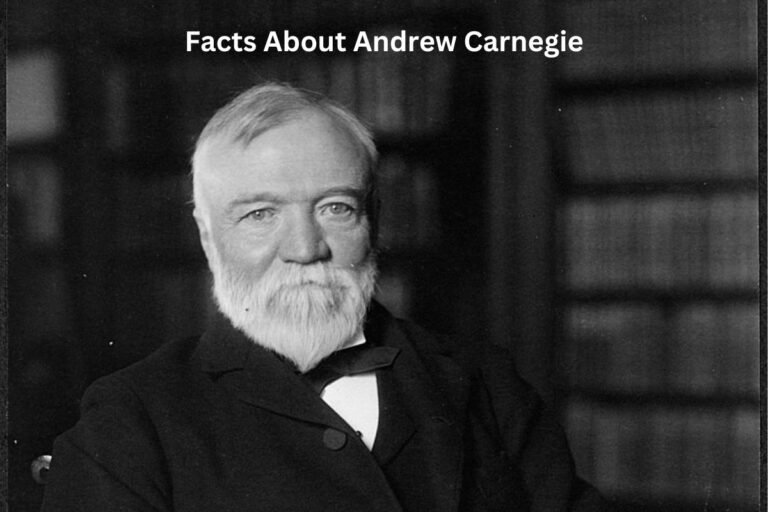Andrew Carnegie was a Scottish-American industrialist and philanthropist who played a pivotal role in the expansion of the American steel industry during the late 19th century. Born on November 25, 1835, in Dunfermline, Scotland, Carnegie immigrated to the United States with his family in 1848. He rose from a poverty-stricken childhood to become one of the wealthiest men of his era. Carnegie is best remembered for his steel empire, his advocacy for world peace, and his extensive philanthropy.
Early Life and Immigration to America
Andrew Carnegie was born to a family that faced significant financial difficulties in Scotland. His father, a handloom weaver, struggled to find work due to the Industrial Revolution, which mechanized much of the weaving industry. This economic hardship forced the family to move to America in search of better opportunities.
In 1848, the Carnegies settled in Allegheny, Pennsylvania. Young Andrew took his first job at 13 as a bobbin boy in a cotton factory, earning $1.20 per week. He later worked as a messenger boy in a telegraph office, where his diligent work ethic and ambition earned him a promotion. These early experiences laid the foundation for his remarkable rise in the business world.
Carnegie’s Rise in the Railroad Industry
Carnegie’s big break came in the 1850s when he began working for Thomas A. Scott of the Pennsylvania Railroad. Under Scott’s mentorship, Carnegie learned valuable lessons about business management and the importance of investing. His role at the railroad gave him a unique insight into logistics and transportation, both critical components of the burgeoning American industrial landscape.
During the Civil War, Carnegie played a crucial role in organizing the Union Army’s telegraph system, which expanded his professional network and skills. His ability to capitalize on opportunities led him to invest in various ventures, including railroads, bridges, and oil.
| Year | Event | Outcome |
|---|---|---|
| 1850s | Joined Pennsylvania Railroad | Learned business management |
| 1860s | Invested in various industries | Built wealth through investments |
Building a Steel Empire
Andrew Carnegie is perhaps most famous for his role in transforming the steel industry. In the 1870s, he established his first steel company, which later evolved into Carnegie Steel. He utilized the Bessemer process, a revolutionary steel-making technique that significantly reduced costs while increasing production. Carnegie’s business acumen, coupled with the technological advances of the time, allowed him to dominate the steel industry.
By the 1890s, Carnegie Steel had become the largest and most profitable steel company in the world, contributing to the infrastructure boom in the U.S., including railroads, bridges, and skyscrapers. In 1901, Carnegie sold his company to J.P. Morgan for $480 million (equivalent to around $15 billion today), making it the cornerstone of U.S. Steel, the first billion-dollar corporation in the world.
| Year | Event | Outcome |
|---|---|---|
| 1870s | Established Carnegie Steel | Revolutionized steel production |
| 1901 | Sold Carnegie Steel to J.P. Morgan | Created U.S. Steel, became a billionaire |
Andrew Carnegie’s Wealth and Philanthropy
Despite amassing a vast fortune, Andrew Carnegie is best known for his philanthropic efforts. He believed in the “Gospel of Wealth,” the idea that wealthy individuals had a moral obligation to distribute their wealth for the greater good. He famously wrote, “The man who dies rich dies disgraced.”
Throughout his lifetime, Carnegie donated over $350 million, equivalent to over $11 billion today. His contributions funded over 2,500 public libraries worldwide, established universities, and supported scientific research. Carnegie Mellon University, the Carnegie Institution for Science, and the Carnegie Endowment for International Peace are just a few of the lasting legacies of his philanthropy.
| Philanthropic Contributions | Amount Donated | Legacy Created |
|---|---|---|
| Public Libraries | Over $60 million | 2,500 libraries worldwide |
| Carnegie Mellon University | Over $10 million | Leading educational institution |
| Carnegie Endowment for International Peace | Over $10 million | Prominent institution advocating for world peace |
The Gospel of Wealth
One of the most defining aspects of Carnegie’s legacy is his philosophy on wealth distribution, known as the “Gospel of Wealth.” Carnegie argued that the wealthy had a duty to use their riches to improve society. Rather than giving directly to the poor, he believed in creating opportunities for self-improvement through education and access to knowledge.
In his 1889 essay “The Gospel of Wealth,” Carnegie wrote, “The proper administration of wealth is a sacred trust which its possessor is bound to administer in his lifetime for the good of the community.” His view contrasted with the more traditional practice of passing down wealth through inheritance, advocating instead for using wealth to benefit society at large.
Major Philanthropic Projects
Andrew Carnegie’s philanthropic efforts spanned many areas, including education, scientific research, peace advocacy, and arts promotion. One of his most significant contributions was funding the construction of libraries. Carnegie believed that access to books was key to personal development, and he helped establish free public libraries across the U.S., U.K., and other parts of the world.
He also funded the establishment of Carnegie Hall in New York City, one of the most famous concert venues in the world, and the Carnegie Corporation of New York, which supports educational and cultural initiatives to this day.
| Year | Major Philanthropic Projects | Impact |
|---|---|---|
| 1880s-1900s | Funded 2,500+ libraries | Global access to knowledge |
| 1891 | Established Carnegie Hall | Premier cultural institution |
| 1911 | Founded Carnegie Corporation | Ongoing support for education |
Legacy and Influence
Andrew Carnegie’s influence extends far beyond his business achievements. His legacy as a philanthropist set a precedent for wealthy individuals to give back to society. He is often regarded as one of the most significant philanthropists in history, inspiring figures such as Bill Gates and Warren Buffett to follow in his footsteps.
His contributions to the steel industry laid the groundwork for the modern infrastructure of the United States, and his dedication to education and world peace continues to impact institutions today. Carnegie’s life is a testament to the power of hard work, vision, and generosity.
Conclusion
Andrew Carnegie’s life exemplifies the potential of hard work, vision, and generosity. From his humble beginnings as a poor immigrant to becoming one of the wealthiest and most influential men of his time, Carnegie’s journey is a classic rags-to-riches story. His revolutionary impact on the steel industry and his enduring philanthropic efforts have left a lasting legacy that continues to shape the modern world.
FAQs about Andrew Carnegie
How did Andrew Carnegie become wealthy?
Andrew Carnegie became wealthy through his investments in railroads, oil, and, most notably, his domination of the steel industry with Carnegie Steel.
What is Andrew Carnegie’s philosophy on wealth?
Carnegie believed in the “Gospel of Wealth,” which advocated for the rich to use their wealth for the benefit of society rather than for personal gain.
How much money did Andrew Carnegie give to charity?
Andrew Carnegie donated over $350 million to various philanthropic causes, including libraries, universities, and world peace efforts.
What industries did Andrew Carnegie work in?
Carnegie worked in multiple industries, including railroads, telegraph systems, and oil, but he is best known for his role in revolutionizing the steel industry.
What is Carnegie’s legacy today?
Carnegie’s legacy lives on through institutions such as Carnegie Mellon University, Carnegie Hall, and the thousands of public libraries he funded.
What was Carnegie’s view on philanthropy?
Carnegie believed that the wealthy had a responsibility to use their fortunes for the public good, a philosophy outlined in his essay “The Gospel of Wealth.”


